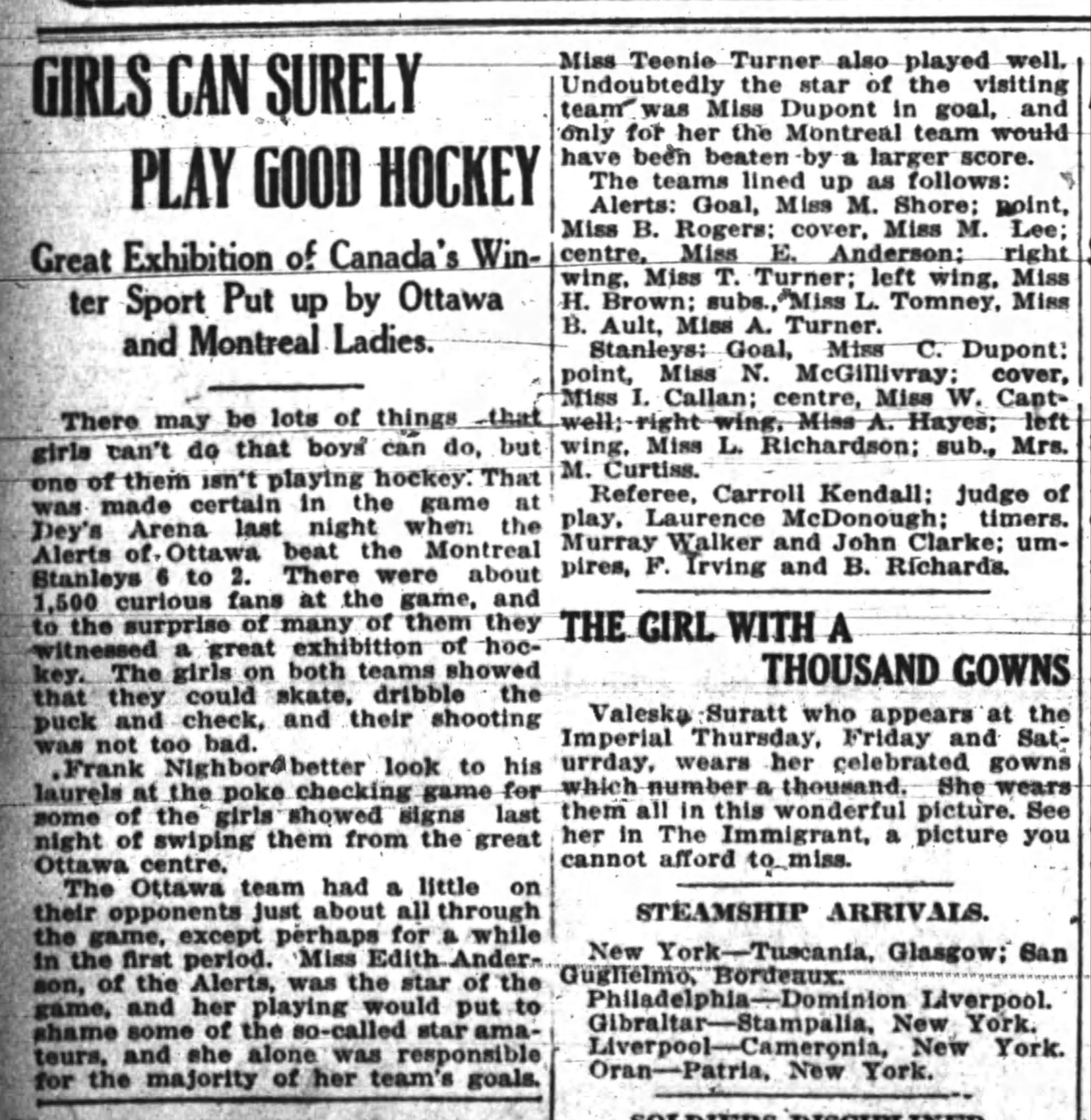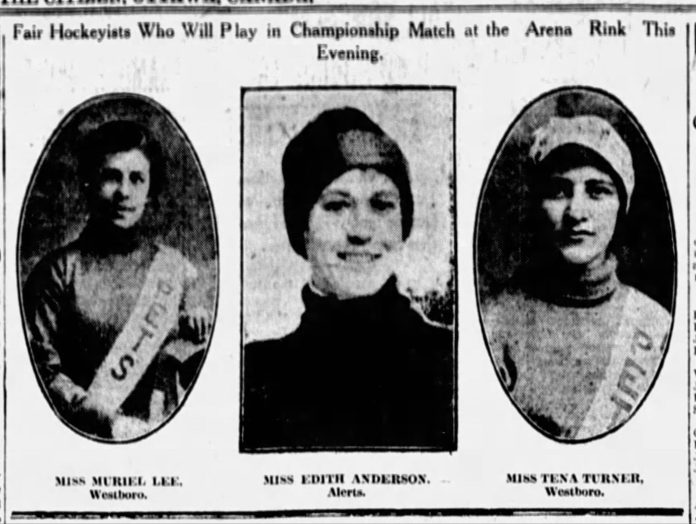By Dave Allston
The movie A League of Their Own brought to life the story of women’s baseball and helped fill a void during the Second World War, with so many men overseas. Less known is a similar story of how women’s hockey became immensely popular in many parts of Canada and the U.S. during the First World War. And it was in the small but growing village of Westboro where one of the top women’s teams emerged.
Though it lasted just two winters more than a century ago, Westboro (population then barely 1,500) was home to a team that played championship-level hockey. They travelled by train throughout eastern Canada and the northern U.S., to exhibit and promote the game, and compete with the best players.
Women certainly played hockey in Ottawa prior to WWI, but games were infrequent and unorganized. Women had limited options in sport – it was often not considered proper or feminine for them to participate. Their early hockey games faced low expectations, but, a report from 1896 noted, “Both teams played grandly and surprised hundreds of the sterner sex who went to the match expecting to see many ludicrous scenes and to have many good laughs.”
But instead, the fans became “wildly enthusiastic.”
Rumours in January 1916 hinted that a league would be formed, to include Montreal, Cornwall, Ottawa and Brockville. And a late entry was the village of Westboro.
Arthur McCarthy was a 32-year-old clerk at Ottawa City Hall, who lived on Victoria Avenue (now Roosevelt) in Westboro. He saw potential in “ladies’ hockey.” Skating and hockey had been popular in Westboro, with many rinks for kids to hone their skills. Westboro men had enjoyed success in city leagues, and girls had been playing quite a bit as well.
It took a month for a team of 13 players to form, and they challenged the Ottawa City team, the Alert, a relatively new team too, managed by Ottawa Senator hockey player Hamby Shore. The Alerts had their sights set on the top teams located in Montreal and Cornwall. However, they agreed to face the Westboro team, who adopted the moniker “the Pets.”
The game on Feb. 21, 1916 had a first-class setting in the Sens’ rink, Dey’s Arena, on Gladstone Avenue. About 1,500 spectators saw the Alerts win 6-2, but the Westboro team played surprisingly well for their first-ever game.

The Pets were led by their star, Tena Turner, 17, daughter of John Turner, who operated John Turner & Sons, a grocery store on Richmond Road, just west of Churchill. Tena was the youngest of eight children in her family, playing centre for the Pets for their two seasons.
The Pets next challenge was a home-and-home series against the vaunted Cornwall Victorias, with another 17-year old player, Albertine Lapensée, considered the greatest female hockey player in Canada (nicknamed the “Ty Cobb of the Cornwall team” and “Miracle Maid”). The Pets lost the opener in Cornwall 3-1 (Lapensée scored all three goals), but the loss was softened in what a significant performance against the dominant Cornwall team. Post-game buzz was huge, not only about Lapensée, but also the surprisingly skill of the Westboro Pets.
The next game was highly promoted, with the National Hockey Association appointing Horace Merrill, captain of the Ottawa Senators, to referee it. The largest ever crowd – 3,800 fans – to watch a women’s game, packed Dey’s Arena. Westboro was allowed to borrow two ringers, Muriel Lee and Edith Anderson from the Alerts.
However, a near riot ensued at the arena on game night. The Alerts and Cornwall teams were scheduled to play each other a few nights later, followed by games in Cleveland, Pittsburgh, Boston and New York. The tour organizer was taking advantage of the ladies hockey craze to showcase the best Canadian female hockey players and make money. With no stake in the Westboro-Cornwall game, the promoter barred Lapensée, wanting her first appearance in Ottawa to be in his Alerts-Cornwall game instead.
Compounding matters, the Cornwall team arrived by train with only six players, just enough to play. Cornwall’s manager insisted Lapensée play against Westboro, but the tour promoters threatened to take out an injunction to stop her. The crowd at the arena was kept waiting as all this was being sorted out, chanting and calling for the game to begin. In the end, Lapensée was allowed to play, and Cornwall won 5-2, on the back of a player the Ottawa Citizen called “the frail little maiden from the banks of the St. Lawrence.”
“Westboro wore blue jerseys with the word “Pets” inscribed across a white band,” in the newspaper’s report. “Cornwall wore white sweaters plus a blue V, while all the fair players were togged out in the customary ‘bloomers’ hockey stockings and speed boots. Miss Lapensée’s tube skates created a furore, and another dainty miss caused a mild sensation when she appeared in pink elastic knee supporters.”
The women’s game was a financial bonanza. The newspaper coverage was on par with what the men’s NHA games were receiving. The U.S. trip brought Lapensée international stardom, as her Cornwall team defeated the Alerts in all three games. Lapensée scored 13 of her team’s 18 goals.
All this with no formal league in existence. Games were scheduled ad hoc, based on invitations to play from various teams and towns.
The Pets would continue to play across eastern Ontario and western Quebec over the next two seasons. Their roster included largely single, unmarried girls (with just three exceptions), the main players being Tena Turner and her older sister Annie, Katie and Nellie Mears, Blanche Snider (who took a “continuous parade to and from the penalty bench”), Edith and Cora Storey, Dorothy Peaker, Gladys Montgomery, Annie Rusland, Violet Hayes, and Arthur McCarthy’s wife Myrtle – their starting goaltender in 1917, who doubled as chaperone on road trips.

Expectations were high going in to the 1917 season. A pre-season fundraising dance in Westboro’s Beatty’s Hall provided new jerseys and equipment, while McCarthy booked ice time from Dey’s Arena for practices.
After their opening game, the Montreal Star wrote “the Pets are perhaps the most accomplished set of skaters ever seen in Cornwall,” though Westboro lost 5-2 in front of a full house. Tena Turner was shook up by a second period collision. Turner returned for the third period with her neck bandaged, and “played a rattling game.”
A mid-February 1917 Pets-Alerts game had a lot at stake – the winner would get the very unofficial title of Canadian champions, and a journey to Pittsburgh to take on the Winter Garden Girls for the “World” championship. Interest was high, the stands were packed, bookies were taking bets. And Westboro lost 2-1.
Their most notable win came in March of 1917, when they became the first team to beat Cornwall, who hadn’t lost in 14 previous games. Lapensée was not in Cornwall’s line-up that time.
An inter-city league was established, led in part by the promotional efforts of Ted Dey, who took over management of the Alerts after Hamby Shore died from influenza.
However, Westboro was not in the new league. Following the 1917 season, McCarthy left Westboro, and the club disbanded. Turner joined the Alerts in 1919 and became captain. She later played for Renfrew after marrying a local man there.
By the early 1920s, some of the novelty of women’s hockey had worn off and the media had refocused on men’s hockey, but the game continued to grow. Regular leagues were established, and early teams like the Ottawa Alerts, Montreal Westerns and Cornwall Victorias had stronger competition. In 1933 the Dominion Woman’s Amateur Hockey Association was established, and a trophy donated by Lady Bessborough, wife of the governor general.
A women’s hockey saga which began right here in Westboro.
